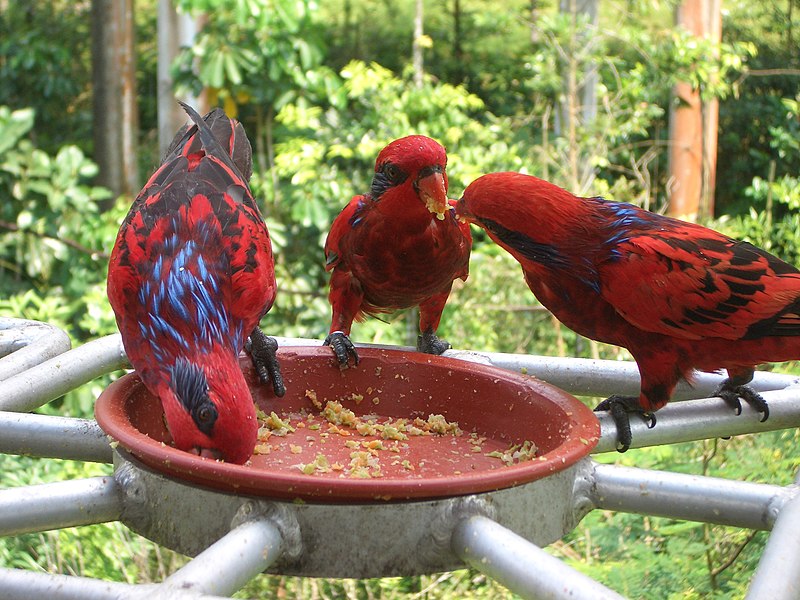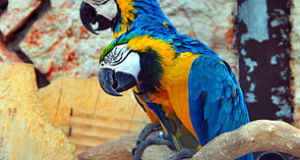 In the wild, the pair-bond between mated parrots often lasts a lifetime. Captive pairs, however, face unique “relationship challenges” that often complicate the mating process. Owners may find it difficult to find two birds that get along, and even long-established pairs may suddenly begin to fight.
In the wild, the pair-bond between mated parrots often lasts a lifetime. Captive pairs, however, face unique “relationship challenges” that often complicate the mating process. Owners may find it difficult to find two birds that get along, and even long-established pairs may suddenly begin to fight.
Mate Choice
Parrot breeding is rarely as simple as putting 2 birds of the opposite sex together…both males and females can be quite choosy when it comes to selecting a mate. Coloration, behavior, vigor and a host of factors that we do not fully understand all come into play, with the ultimate goal being the production healthy offspring. The process has evolved over millions of years, and works fine in natural situations, where the birds can choose from numerous potential mates.
Captives face an entirely different situation. Even in large breeding groups, they are limited to a fraction of the potential mates that would be available in the wild. Being naturally social, many parrots “give in” and accept whatever mate, or same sex friend, presents itself; parrots that live alone often transfer their need for companionship to human owners.
Imprinting
Owner-bonded birds, especially those that have been hand-raised, often reject mates. One Great Horned Owl that I reared courted me by attempting to stuff mice in my mouth, but attacked or retreated from others of his kind. In many cases, such birds must be kept alone.
Age and Hormone Levels
Differences in age and fluctuating hormone levels can affect pair formation. Older birds, especially if they have lived alone for a time, may be ready to mate before their partners are sexually mature.
Recently-acquired birds will need time to adjust to their new homes. If they are placed into another’s cage, the original bird may seek to bond or mate too quickly. Either may then attack the other.
In natural situations, the hormone levels of mature males and females are in sync, so that both will be ready to mate at the same time. Pets are not often exposed to normal day/night cycles, weather patterns, air pressure changes and other conditions that affect breeding readiness (remember, these factors have molded parrot evolution for millions of years). While captives will survive unnatural conditions, their hormone production can be affected. Therefore, one parrot’s hormones may be stimulating it to reproduce, while its mate is being signaled to avoid reproductive behavior.
Close Confinement
In addition to parrots, I have worked with many other animals that are known to form strong pair bonds or mate for life – cranes, swans, wolves, certain lizards and fishes and even some invertebrates, such as arrow crabs. In just about every situation, the very fact of confinement has led to “domestic disturbances”.
Wild parrots are occupied with the business of surviving for most of their waking hours, and usually are also interacting with others of their kind in addition to their mates. In captivity, their needs for food and shelter are usually met with little or no effort, leaving much idle time. For highly intelligent, active creatures such as parrots, this often translates into self-destructive behaviors and mate aggression (I’ll leave you to draw your own “Idle hands are the devil’s workshop” human parallels!).
What to Look For
Outright aggression is easy to spot, but there can be less obvious signs that all is not well between parrot pairs. A dominant bird’s presence alone can be enough to intimidate its mate, even without physical attacks. Subordinate birds may not have a chance to feed properly, and often appear either nervous or listless. In addition to nutritional problems, the stress of being caged with an aggressor weakens the immune system and will lead to illness and disease.
While males are often the guilty parties when it comes to mate aggression, females can be just as bad. This is especially true where the female is older than the male or has a more dominant personality, and among Eclectus Parrots, where females seem to be the “stronger” sex.
What to Do

In cases of minor aggression, try reducing boredom by adding variety to the cage’s furnishings, toys, out-of-cage time and so on. In outdoor aviaries, live plants and branches can be used as sight barriers and to allow each bird some privacy.
Further Reading
Mate Choice in Budgies: Opposites do not Attract
Eclectus Parrot Breeding Strategies
Ultra-Violet Vision and Mate Choice in Parrots
Blue-Steaked Lory image referenced from wikipedia and originally posted by Snowmanradio
Blue-Steaked Lory image referenced from wikipedia and originally posted by Snowmanradio
 That Bird Blog – Bird Care and History for Pet Birds
That Bird Blog – Bird Care and History for Pet Birds



